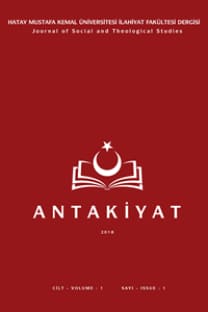Mizah Tarzlarının Dinî Yönelim Üzerindeki Etkisi
Din Psikolojisi, Dinî Yönelim, Mizah, Mizah Tarzları, Olumlu Mizah, Olumsuz Mizah.
The Effect of Humor Styles on Religious Orientation
The Psychology of Religion, Religious Orientation, Humor, Humor Styles, Positive Humor, Negative Humor. Din Psikolojisi, Dinî Yönelim, Mizah, Mizah Tarzları, Olumlu Mizah, Olumsuz Mizah.,
___
- Allport, G. W. (1961). Pattern and growth in personality. Holt, Rinehart and Winston.
- Altınay, R. (2004). İslam mizahının ortaya çıkışı ve ilk örnekleri I. Nüsha, 4(15), 77-96.
- Aristoteles. (2004). Retorik (M. H. Doğan, Çev.). Yapı Kredi Yayınları.
- Doğan, Y. (2004). Hz. Peygamber ve mizah. Cumhuriyet Üniversitesi İlahiyat Fakültesi Dergisi, 8(2), 191-203.
- Emre, Y. (2019). Üniversite öğrencilerinde mizah anlayışı ve dindarlık: Çukurova üniversitesi örneği [Yayınlanmamış doktora tezi]. Çukurova Üniversitesi Sosyal Bilimler Enstitüsü.
- Emre, Y. (2020a). Bazen mizah sadece güldürmez: Din ve mizah üzerine teorik bir yaklaşım. İçinde Z. Sağır (Ed.), Din Psikolojisi Teori, Güncel Araştırmalar ve Yeni Eğilimler (ss. 159-182). Dem yayınları.
- Emre, Y. (2020b). Din ve mizah. Eskiyeni Yayınları.
- Emre, Y. & Özgen, G. (2017). İlahiyat fakültesi öğrencilerinin mizah anlayışlarının bazı değişkenlere göre incelenmesi. Çukurova Üniversitesi İlahiyat Fakültesi Dergisi (ÇÜİFD), 17 (1), 277-298.
- Feinberg, L. (2004). Mizahın sırrı. Millî Folklor, 16(62), 105-113.
- Frankl, V. E. (2009). İnsanın anlam arayışı (S. Budak, Çev.). Okuyan Us Yay.
- Freud, S. (2003). Espiriler ve bilinçdışı ile ilişkileri (E. Kapkın, Çev.). Payel Yayınevi.
- Hobbes, T. (2007). Leviathan veya bir din ve dünya devletinin içeriği, biçimi ve kudreti (S. Lim, Çev.). Yapı Kredi Kültür Sanat Yayıncılık.
- Karaca, F. (2000). Ölüm psikolojisi. Beyan Yayınları.
- Karaca, F. (2001). Din psikolojisinde metot sorunu ve bir dindarlık ölçeğinin Türk toplumuna standardizasyonu. EKEV Akademi Dergisi, 3(1), 187-201.
- Kirsh, G., & Kuiper, N. (2003). Positive and negative aspects of sense of humor: Associations with the constructs of individualism and relatedness. Humor-international Journal of Humor Research-HUMOR, 16, 33-62.
- Köten, A. (1994). Asr-ı saadette mizah. İçinde V. (Ed.) Akyüz, Bütün yönleriyle asr-ı saadette İslam (C. 4, ss. 455-484). Beyan Yayınları.
- Kuiper, N. A., Martin, R. A., & Olinger, L. J. (1993). Coping humour, stress, and cognitive appraisals. Canadian Journal of Behavioural Science, 25(1), 81-96.
- Lefcourt, H. M., & Martin, R. A. (1986). Humor and life stress. Springer-Verlag.
- Martin, R. A. (2000). Humor and laughter. Encyclopedia of Psychology, Vol. 4. (ss. 202-204). American Psychological Association.
- Martin, R. A. (2007). The psychology of humor: An integrative approach. Elsevier Academic Press.
- Martin, R. A., Puhlik-Doris, P. L., Gray, J., & Weir, K. (2003). Individual differences of uses of humor and their relation to psychological well-being: Development of the Humor Styles Questionnaire. Journal of Research in Personality, 37(1), 48-75.
- Maslow, A. H. (1954). Motivation and personality. Harper & Row, Publishers Inc.
- Özgen, G. (2014). Üsküdar bölgesinde görev yapan öğretmenlerin mizah tarzları ve dini başaçıkma tarzları arasındaki ilişki (Yayınlanmamış yüksek lisans tezi). Marmara Üniveristesi Sosyal Bilimler Enstitüsü.
- Platon. (2013). Philebos (F. Akderin, Çev.). Say Yayınları.
- Saroglou, V. (2004). Being religious implies being different in humour: Evidence from self- and peer-ratings. Mental Health, Religion & Culture, 7(3), 255-267.
- Semrud-Clikeman, M., & Glass, K. (2010). The relation of humor and child development: Social, adaptive, and emotional aspects. Journal of Child Neurology, 25(10), 1248-1260.
- Thorson, J. A., & Powell, F. C. (1993). Development and validation of a multidimensional sense of humor scale. Journal of Clinical Psychology, 49(1), 13-23.
- Treger, S., Sprecher, S., & Erber, R. (2013). Laughing and liking: Exploring the interpersonal effects of humor use in initial. European Journal of Social Psychology, 43, 532-543.
- Türer, O. (2003). Latife. İçinde TDV İslâm Ansiklopedisi (C. 27, s. 110). Türkiye Diyanet Vakfı İslam Araştırmaları Merkezi.
- Ulloth, J. K. (2002). The benefits of humor in nursing education. Journal of Nursing Education, 41(11), 476-481.
- Yerlikaya, E. E. (2003). Mizah Tarzları Ölçeği`nin (Humor Styles Questionnaire) uyarlama çalışması (Yayınlanmamış yüksek lisans tezi). Çukurova Üniversitesi Sosyal Bilimler Enstitüsü Eğitim Bilimleri Anabilim Dalı.
- Yerlikaya, E. E. (2009). Üniversite öğrencilerinin mizah tarzları ile algılanan stres, kaygı ve depresyon düzeyleri arasındaki ilişkinin incelenmesi (Yayınlanmamış doktora tezi). Çukurova Üniversitesi Sosyal Bilimler Enstitüsü.
- Yılmaz, H. (2004). Hz. Peygamber’in eğitiminde bir ilke olarak hoşgörü. Cumhuriyet Üniversitesi İlahiyat Fakültesi Dergisi, 8(1), 109-132.
- Yayın Aralığı: Yılda 2 Sayı
- Başlangıç: 2018
- Yayıncı: Mustafa Kemal Üniversitesi
Hadis Metninin Sünnete Arzı: Hadisciler ve Çağdaş Fikrin Konuya Yaklaşımı
İbn Hibbân’ın Kitâbu’l-Mecrûhîn’de Kullandığı Metin Tenkiti Esasları
Dilcilerin Kırâate Yaklaşımı: Sîbeveyh Örneği
Fıkıh Usulünde Kâsır İlletle Ta‘lîl Meselesi
Yusuf BULUTLU, Mohammad ALİ YOUSEF ABU-EİD
İstahrî’nin Fıkhî Yönü ve İbadetler Bağlamında Muhalif Görüşleri
Rivayetlerde Kıraatler Açısından Hz. Osman Mushafı’nın Kaynaklığı
Oghız Najmaldeen Sulıman SULIMAN, Ahsen YILMAZ
Kitâbü’t-Tenbih ve’l-İşraf (Coğrafya ve Tarih) Müellif: Mes‘ûdî
Mizah Tarzlarının Dinî Yönelim Üzerindeki Etkisi
Hatay (Arap) Alevilerinde Kutsal Bir Zaman Olarak Gadir-i Hum Bayramı ve Kutlama Gelenekleri
